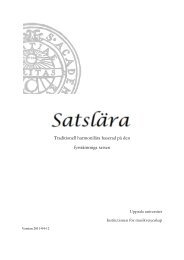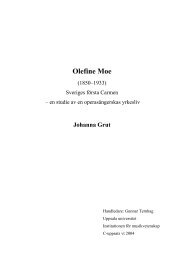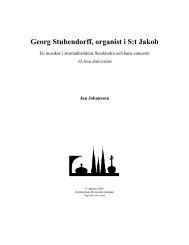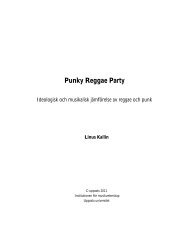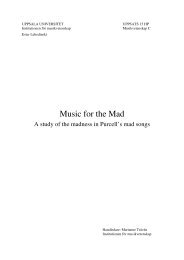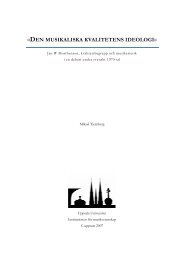What Does Donna Lee Mean? - Institutionen för musikvetenskap ...
What Does Donna Lee Mean? - Institutionen för musikvetenskap ...
What Does Donna Lee Mean? - Institutionen för musikvetenskap ...
Create successful ePaper yourself
Turn your PDF publications into a flip-book with our unique Google optimized e-Paper software.
Theoretical background<br />
This entire chapter builds upon the semiological tripartition theory in its application to<br />
musical analysis as exposed by Jean-Jacques Nattiez in his book Music and Discourse (1990).<br />
Analytic discourse as a metalanguage<br />
As Jean-Jacques Nattiez claims, at least until recent times it has been unusual for<br />
musicologists to undertake a meta-reflection of the methods employed in their own discipline<br />
(Nattiez 1990: 150). Musicology, both in its historic and systematic approaches, is a symbolic<br />
construct whose function is to explain another symbolic system. Thus, in its desire to explain<br />
the musical fact, musicology cannot escape being biased by language.<br />
Nattiez believes that it is common for some people to not feel comfortable with the idea that<br />
music can or needs to be explained (1990: 151). Those in favour of this view might tend to<br />
see a musicological analysis as an act of ”betrayal” to what the essence of music is: to<br />
communicate without words. For them, as soon as music is explained with words, it becomes<br />
fixed, literal and deprived of what constitues its basic characteristic: its ”openness”, its<br />
reference to a non-verbal signifier, its capacity to express the ”ineffable”.<br />
<strong>What</strong> is musical meaning?<br />
Nattiez proposes a general definition of meaning that suits our purposes: ”An object of any<br />
kind takes on meaning for an individual apprehending that object, as soon as that individual<br />
places the object in relation to areas of his lived experience – that is, in relation to a collection<br />
of other objects that belong to his or her experience of the world” (1990: 9). The definition<br />
includes all kinds of possible objects: from physical phenomenons concerning earthly matter<br />
to personal or social facts, abstract concepts, words, ideologies, etc. It stresses the fact that<br />
any study of how an object functions symbollically must happen, first and foremost, at an<br />
individual level. It is this level of functioning which makes possible the further study at other<br />
levels and allows us to determine how meaning can also be constructed collectively or in<br />
interpersonal interactions. The definition understands meaning as something that is<br />
apprehended; in a way, constructed, as opposed to perceived. The meaning of an object is a<br />
transaction between the receiver and the producer.<br />
The semiological tripartition<br />
Nattiez states that when a symbolic object, a text, a work, etc., enters the biographic horizon<br />
of an individual, the result is the creation of a new constellation of symbols in endless<br />
interactive web of symbols ”playing” with one another. The meaning of a text is not the<br />
product of the transmission of a message that a receiver translates thanks to his knowledge of<br />
3



